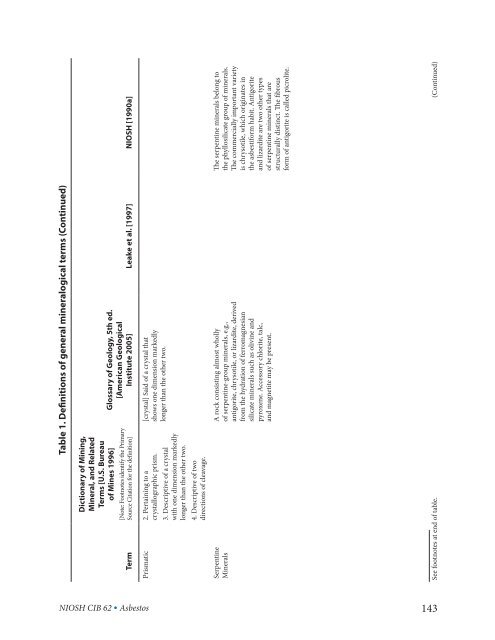Asbestos Fibers and Other Elongate Mineral Particles: State of the ...
Asbestos Fibers and Other Elongate Mineral Particles: State of the ...
Asbestos Fibers and Other Elongate Mineral Particles: State of the ...
- No tags were found...
You also want an ePaper? Increase the reach of your titles
YUMPU automatically turns print PDFs into web optimized ePapers that Google loves.
Table 1. Definitions <strong>of</strong> general mineralogical terms (Continued)<br />
Glossary <strong>of</strong> Geology, 5th ed.<br />
[American Geological<br />
Institute 2005] Leake et al. [1997] NIOSH [1990a]<br />
Dictionary <strong>of</strong> Mining,<br />
<strong>Mineral</strong>, <strong>and</strong> Related<br />
Terms [U.S. Bureau<br />
<strong>of</strong> Mines 1996]<br />
[Note: Footnotes identify <strong>the</strong> Primary<br />
Source Citation for <strong>the</strong> definition]<br />
Term<br />
NIOSH CIB 62 • <strong>Asbestos</strong><br />
[crystal] Said <strong>of</strong> a crystal that<br />
shows one dimension markedly<br />
longer than <strong>the</strong> o<strong>the</strong>r two.<br />
Prismatic 2. Pertaining to a<br />
crystallographic prism.<br />
3. Descriptive <strong>of</strong> a crystal<br />
with one dimension markedly<br />
longer than <strong>the</strong> o<strong>the</strong>r two.<br />
4. Descriptive <strong>of</strong> two<br />
directions <strong>of</strong> cleavage.<br />
The serpentine minerals belong to<br />
<strong>the</strong> phyllosilicate group <strong>of</strong> minerals.<br />
The commercially important variety<br />
is chrysotile, which originates in<br />
<strong>the</strong> asbestiform habit. Antigorite<br />
<strong>and</strong> lizardite are two o<strong>the</strong>r types<br />
<strong>of</strong> serpentine minerals that are<br />
structurally distinct. The fibrous<br />
form <strong>of</strong> antigorite is called picrolite.<br />
A rock consisting almost wholly<br />
<strong>of</strong> serpentine-group minerals, e.g.,<br />
antigorite, chrysotile, or lizardite, derived<br />
from <strong>the</strong> hydration <strong>of</strong> ferromagnesian<br />
silicate minerals such as olivine <strong>and</strong><br />
pyroxene. Accessory chlorite, talc,<br />
<strong>and</strong> magnetite may be present.<br />
Serpentine<br />
<strong>Mineral</strong>s<br />
See footnotes at end <strong>of</strong> table. (Continued)<br />
143

















